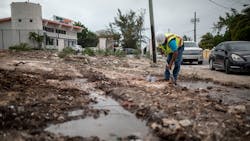Smart water boosts resilience for post-hurricane recovery
Freshwater — one of the world’s most precious resources — is quickly becoming scarcer. By 2025, an estimated 3 billion people in 48 countries will face water scarcity, and by 2030 global water demand will increase by 40 percent.
From increased food production and energy requirements to rising temperatures from the effects of climate disruption, it is clear that increasing demand is having an unsustainable impact on our water supply.
Beyond a growing demand for water, natural disasters such as hurricanes — which are becoming more frequent and extreme — are wreaking havoc on water services.
This was the case in 2017 when Hurricane Irma brought severe winds and destruction to the Turks and Caicos Islands. Winds reached over 170 miles per hour with gusts over 200 miles per hour, causing damage to 90 percent of properties, leaving incredible devastation in its wake. For example, in Providenciales (also known as Provo), water to the island had to be cut to manage a catastrophic flow.
Scarcity and water loss issues are a reality for utilities around the world. While solving these challenges will take cooperation from all stakeholders, utilities play an essential role in ensuring supply can keep up with demand. Embracing technology such as advanced metering infrastructure (AMI) and data analytics can reduce water loss and boost conservation efforts, moving us forward in the right direction and ensuring every drop counts.Counting every drop with smart water solutions
The Turks and Caicos Islands is an archipelago of 40 islands and cays in the Atlantic Ocean. Provo is the most developed island within Turks and Caicos and the largest by population. It is known for its beautiful beaches and turquoise water, attracting visitors from around the world.
Ironically, while surrounded by clear water, Provo, like the rest of Turks and Caicos, does not have any naturally occurring fresh water. Instead, Provo Water Company (PWC) uses desalination to turn seawater into drinkable water.
“This means fresh water comes at a high cost. Water shortages are being experienced in all corners of the globe, so it is important that we conserve water and use it efficiently,” said Cora Malcolm, project and data manager of PWC in the TV series “After the Storm” in 2022.
To help conserve water and improve the efficiency of its water system, PWC implemented an Itron AMI system. The decision was spurred by the fact that they were experiencing 18 to 21 perfect water loss in their network. This rate is aligned with the rest of the world — where globally, over a third of water pumped from distribution plants is lost before it ever reaches a consumer. This number is too high for a resource as precious as water, and it is where an intelligently connected metering system comes into play.
AMI provides unprecedented visibility into a water distribution network, making it possible to reduce — or even eliminate — non-revenue water (NRW) usage. In the case of PWC, it was able to reduce NRW and drive water conservation by decreasing the time it took to receive data by 98%.
AMI proved helpful in reducing leaks during normal conditions in ways PWC had not considered.
“We never could have anticipated the importance that [the] AMI system played in our recovery after Hurricane Irma,” Malcom said.
Getting the water flowing again after Hurricane Irma
After Hurricane Irma hit the Turks and Caicos Islands, Provo Water lost nearly 3 million gallons of water — 50% of its stored water reserves — due to a catastrophic flow. As a result, the decision was made to cut water to the surrounding community, including all their schools, homes, hospitals and airports, to stabilize the system. While the decision to cut off water is never taken lightly, it was necessary to repressurize the system.
“It was essential that we get the water back up and running to get the community back up and running,” Malcom said.
With the real-time data, Provo Water was able to understand the flow rate and where the leaks were located.
“Previously, when doing leak detection work, it could take anywhere from seven days to 14 days before a leak could be identified,” Malcolm said. “That is because the engineers manually went out and read all the meters under a district. With AMI, we are able to get those readings every hour.”
This real-time data meant resources could be focused on where they were needed the most.
Without the insight gathered from the smart meters, a manual review of the entire island would have been ordered. Not only would the process have taken weeks, but it would have also put employees in unnecessarily dangerous situations. Instead, with an AMI solution, water flowed again within four days.
Modern solutions for an industry in transition
Provo Water experienced firsthand the benefit of a smart water solution during a devastating natural disaster. Provo Water restored full services and fully pressurized the system in 2.5 weeks. Without AMI, the process would have taken closer to two to three months.
While AMI can play a major role in getting water flowing again after a major disaster, it also plays a major role in everyday water conservation efforts. With water losses occurring at high volumes, utilities must look for ways to solve scarcity and water conservation on an ongoing basis.
By embracing modern technology and getting actionable insight into (often aging) water infrastructure, it is possible to reduce non-revenue water loss and give consumers accessible, rich data about their own water consumption.
It will take cooperation from all stakeholders — from end users and corporations to lawmakers — to solve water scarcity issues. Utilities, however, play a unique role in ensuring access to clean and reliable water services, and real-time data and AMI systems are needed to make that a reality. WW
References
- “After the Storm.” 2022. Beneath the Surface BBC StoryWorks. 2022. Video, 5:56, https://www.bbc.com/storyworks/beneath-the-surface/after-the-storm.
About the Author
Sheila Kee
Sheila Kee is a senior product manager of water operations management at Itron.

